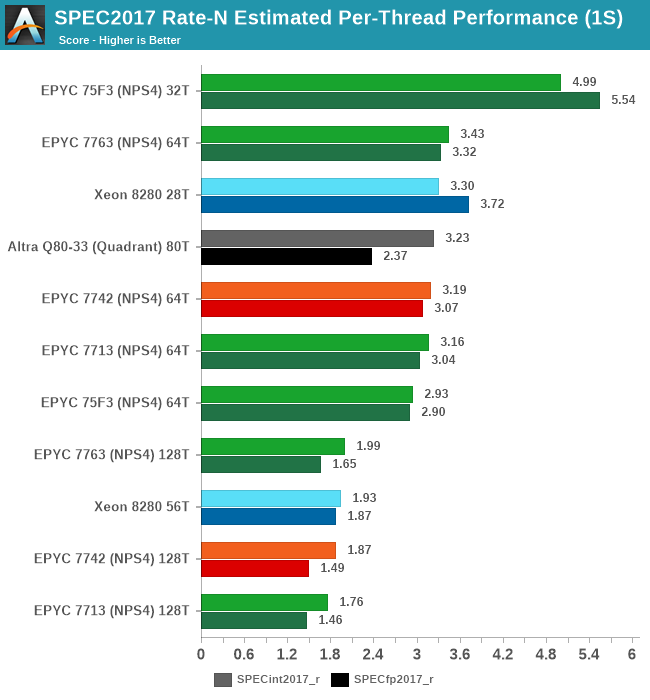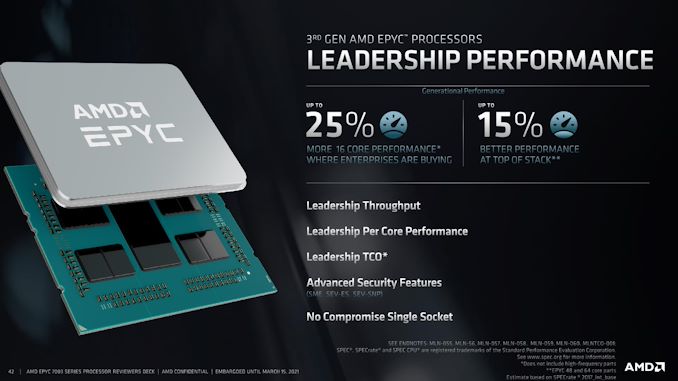AMD 3rd Gen EPYC Milan Review: A Peak vs Per Core Performance Balance
by Dr. Ian Cutress & Andrei Frumusanu on March 15, 2021 11:00 AM ESTDisclaimer June 25th: The benchmark figures in this review have been superseded by our second follow-up Milan review article, where we observe improved performance figures on a production platform compared to AMD’s reference system in this piece.
SPEC - Per-Core Win for "F"-Series 75F3
A metric that is actually more interesting than isolated single-thread performance, is actually per-thread performance in a fully loaded system. This actually is a measurement and benchmark figure that would greatly interest enterprises and customers which are running software or workloads that are possibly licensed on a per-core basis, or simply workloads that require a certain level of per-thread service level agreement in terms of performance.
It’s precisely this market that AMD is trying to target with its new “F”-series of processors, and this is where the new 75F3 comes into play. With 32 cores, 4 cores per chiplet with the full 256MB of L3 cache, and a base frequency of 2.95GHz, boosting up to 4.0GHz at a default 280W TDP, is the chip is squeezing out the maximum per-core performance while still offering a massive amount of multi-threaded performance.

At full load, this ends up with a massive per-thread performance leadership on the part of the 75F3, landing 45% ahead of the 7763 and 51% ahead of the Intel Xeon 8280.
It’s to be noted that limiting the thread count of the higher core-count SKUs will also result in a better per-thread performance metric, for example running a 7713 with only 32 threads will result in a SPECint2017 estimated score of 4.30 – the 75F3 still has a 16% advantage there even though its boost clock is only 8.8% higher at the peak – meaning the 75F3 is achieving higher effective frequencies. Unfortunately, we didn’t have enough time to do the same experiment on the equal 280W 7763 part.
AMD discloses that the biggest generational gains for the Milan stack is found in the lower core-count models, where for example the 7313 and the 7343 outperforms the 7282 and 7302 by 25%. Reason for this is that for example the new 7313 features double the L3 cache, and all the new CPUs are boosting higher with respectively higher TDPs, increasing to 150/190W from 120/155W, as well as landing in at +50% higher price points when comparing generation to generation.











120 Comments
View All Comments
Memo.Ray - Monday, March 15, 2021 - link
Thanks for the excellent review team Anand!ballsystemlord - Monday, March 15, 2021 - link
Actually, it was Ian and Andrei, not Anand who did the review. I'm not joking, he's a real person who used to work on this site: https://www.anandtech.com/print/1635/velanapontinha - Monday, March 15, 2021 - link
He was not addressing Anand. He is adressing "team Anand" which obviouisly means "the people actually workin on Anandtech"ballsystemlord - Monday, March 15, 2021 - link
I was thinking of a one person (Anand) team. ;)I should have gotten what he said though.
Gothmoth - Monday, March 15, 2021 - link
Team Anand! Since when is a team a single person....bigboxes - Tuesday, March 16, 2021 - link
He didn't get that. Must have missed the "team"plonk420 - Monday, March 22, 2021 - link
yeah, he was a bit too excited to ACKCHYUALLY someone elseSharma_Ji - Wednesday, March 17, 2021 - link
Who used to work - lolHe is the co founder lol
herozeros - Thursday, March 18, 2021 - link
definitely didn't think comment lurking would make me feel old today. lolMemo.Ray - Monday, March 15, 2021 - link
I know my English is a "lil" rough on the edges but I gotta admit, I didn't see these comments coming! lol.